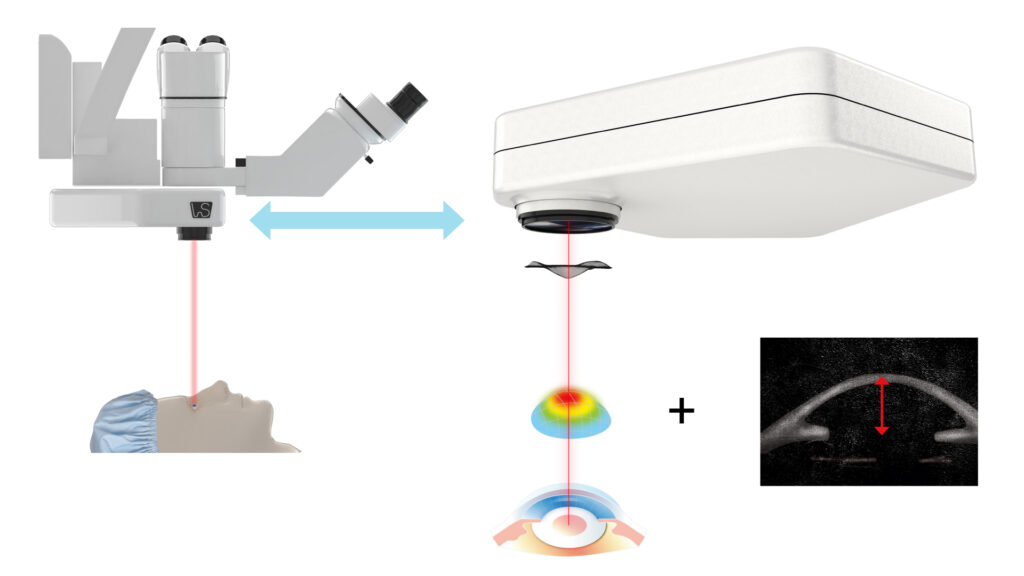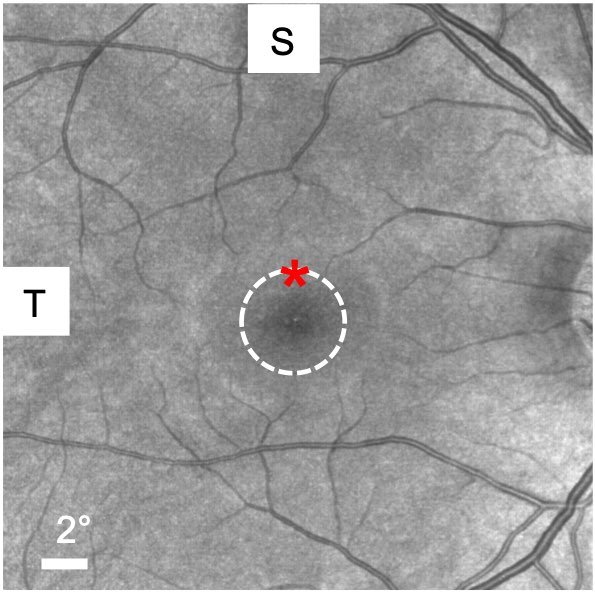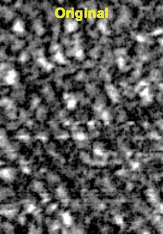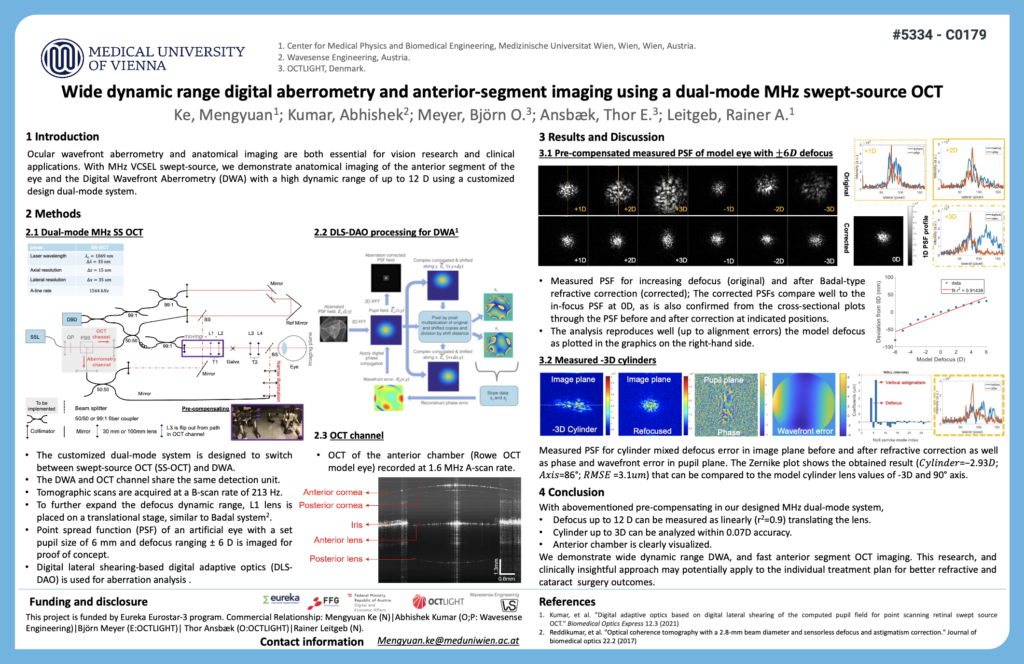First results of the Digital OCT-Aberrometry project presented at ARVO 2023
The first results of the Digital OCT-Aberrometry (DOCTA) project were presented at the ARVO 2023 conference held in New Orleans, LA, USA (April 23-27, 2023). The demonstrated results included a wide dynamic range Digital Aberrometry in combination with Anterior Segment Imaging using a single Multimodal MHz Swept Source OCT system based on a customized modular design. The presented system and the technical approach can provide access to the full optical and anatomical information of patient’s eye which can potentially help clinicians and surgeons to devise customized treatment plan for patients in order to achieve better refractive and cataract surgery outcomes. DOCTA project is a joint collaboration between Wavesense Engineering, OCTlight and Medical University of Vienna. The project is funded by the Eureka’s Eurostars-3 programme.
27 th of April 2023
New Eurostars project to develop novel multi-model OCT device for improving cataract surgery outcome

Figure: A Digital OCT-Aberrometry (DOCTA) device will be developed in the project that can enable wavefront aberrometry together with the conventional OCT imaging of the human eye. Flexible & robust design will allow the sample arm to be mounted on a surgical microscope and to be used during the surgery.
Eurostars has granted public R&D funding to a joint international collaboration between Wavesense Engineering, Medical University of Vienna and OCTLIGHT. The consortium will develop a novel ophthalmic multimodal optical coherence tomography (OCT) device that can provide complete optical and anatomical information of patient’s eye to improve the diagnosis and treatment of eye diseases.
The project is one of the top R&D projects selected for funding by Eurostars-3 program.Eurostars is a program sponsored by EUREKA member countries and the European Commission to support breakthrough innovation. One of the main focus areas of the device developed under the funded project is to significantly improve the outcome of cataract surgery. Cataract, which causes clouding of lens, is the number one cause of blindness in the world with about 94 million people suffering worldwide. A significant portion of the patients undergoing lens replacement surgery are dissatisfied and have to rely on glasses or undergo further vision correction surgery due the limitation of the current state of the art biometric devices and surgical procedure.
As a main result in the project, a multimodal ophthalmic OCT device will be developed, based on a novel and patented digital OCT-aberrometry (DOCTA) technique developed by Wavesense Engineering, that will for the first time provide:
i. 3-in-1 functionalities, i.e., 1) Anterior segment imaging, 2) Posterior segment imaging and 3) Wavefront aberrometry.
ii. Unique sample arm design to achieve high ergonomics and flexibility, such that it can be used in two different configurations: 1) as a surgical microscope mounted intra-operative device and 2) as a tabletop diagnostic device.
This novel DOCTA device can enable surgeons to formulate a personalized treatment plan (e.g. design, power and axis orientation of IOL) for each patient as complete optical and anatomical properties of individual’s eye is known, which can significantly improve the refractive outcome after surgery and help patients achieve 20/20 vision outcomes. Also, the DOCTA device can be used intraoperatively to guide the surgery by measuring at different stages and adapting accordingly to achieve the precise targeted surgical outcome. DOCTA device can be used to guide other ocular surgeries as well to improve the precision, such as keratoplasty, epi-retinal membrane peeling, retinal detachment, vitreous hemorrhage etc. Also, as a tabletop diagnostic device, it can help in precise treatment planning of wavefront guided LASIK surgery for vision correction, and improved diagnosis of several eye diseases such as glaucoma, age-related macular degeneration (AMD), diabetic retinopathy (DR) etc.
CEO of Wavesense Engineering Abhishek Kumar adds: “Wavesense is pleased and honoured to receive the funding by EUREKA Eurostars that can help us develop and demonstrate the full capability of our envisioned product that can potentially enhance the precision of ophthalmic disease diagnosis and surgical outcome, especially cataract, and hence contribute to the improvement of the quality of life of the patients.”
Dr. Frieder Loesel, ophthalmic industry veteran and Managing Director of 20/10 Perfect Vision GmbH, who is advising Wavesense Engineering, describes the significance of the developed product as “Wavesense’s proprietary technology has the potential to help ophthalmologists further improve outcomes across a wide range of procedures, with the ultimate goal of happy patients, and I am delighted to support this effort.”
The Medical University of Vienna (MUW), the birthplace of OCT research in Europe, will support Wavesense Engineering with the R&D of the DOCTA device so that the final device meets the targeted specifications. OCTLIGHT will develop a dual bandwidth phase stable MHz swept source laser (SSL) based on vertical-cavity surface-emitting laser (VCSEL) technology that will enable DOCTA device to operate reliably with high precision. As Prof Rainer Leitgeb, associate professor at MUW, states “MUW is excited to support such important medical technology development with our expertise as well as our multidisciplinary environment which we believe crucial for fast translation to the benefit of patients.”
CEO of OCTLIGHT Thor Ansbæk describes the significance of the funding as: “Based on the overwhelming request from customers we are currently preparing to scale up operations to meet future demand. We see the commercial breakthrough of VCSEL as imminent in the Ophthalmic industry, with industrial and autonomous currently picking up speed.
This project will not only be an important demonstration of our key enabling technology but will also allow us to further adapt our VCSEL swept source laser to make a cost efficient solution for applications that require phase stabilization. The patented Highly Efficient Resonator Oscillator (HERO) underpins the unique advantages allowing MHz A-scan speeds, single channel acquisition and phase stable operation.”About OCTLIGHT
OCTLIGHT is the first in the world to develop and start production of the world´s fastest VCSEL Swept Source for OCT scanners for eye diagnostics. OCTLIGHT supplies the laser module to MedTech companies and other companies globally who want to create innovation with OCTLIGHT´s technology platform in eye diagnostics or in other applications where alightning-fast micrometer precision scans are needed at distances from a few mm up to 100 meters.
OCTLIGHT ApS
Thor Ersted Ansbæk
CEO
Diplomvej 381, Kgs. Lyngby, Denmark
Email: thor@octlight.com
About Wavesense Engineering
Wavesense Engineering, a startup based in Vienna, Austria, is developing a clinical ophthalmic OCT device that can provide not only the anatomical imaging but also the optical information of the patient's eye by combining OCT with a novel digital aberrometry technology–a first of its kind in the world. It can help improve the surgical planning and outcome of the cataract, refractive and other ophthalmic surgical procedure.
Contact:
Abhishek Kumar, PhD
Founder and CEO,
Wavesense Engineering GmbH
Billrothstraße 75/2/10, Vienna 1190, Austria
Email: abhishek.kumar@wavesenseengineering.com
About Medical University of Vienna
The Medical University of Vienna is one of the most traditional medical educational establishments with 8,000 students and approximately 6,000 members of staff and is already one of the most important top-level research establishments in Europe in the biomedical sector. The Center for Medical Physics and Biomedical engineering at MUW is a leading research institution in Europe in the field of biomedical imaging. In particular it was among the first to advance the technology on digital wavefront sensing and aberration correction. With the gained expertise MUW contributes to the optical system design, the hardware and software setup, as well as to the testing, benchmarking, and validation of the system. The multidisciplinary environment provides a perfect basis for a future translation of successful project outcomes.
About Eurostars
Eurostars is a funding instrument that supports innovative SMEs and project partners (large companies, universities, research organisations and other types of organisations) by funding international collaborative R&D and innovation projects. It is an ideal first step in international cooperation, enabling small businesses to combine and share expertise and benefit from working beyond national borders.This project has received funding from the Eurostars-2 joint programme with co-funding from the European Union Horizon 2020 research and innovation programme. The R&D co-funding to project partners Wavesense Engineering and Medical University of Vienna are provided by Austrian Research Promotion Agency (FFG) and Federal Ministry for Digital and Economic Affairs (BMDW) in Austria. The R&D co-funding to project partner OCTLIGHT is provided by Innovationsfonden in Denmark.
26 th of August 2022
Sponsors of the Eurostars DOCTA project

26 th of August 2022
Wavesense Engineering's Digital OCT-Aberrometry (DOCTA) project has been selected for grant funding under Eureka Eurostar-3 programme.
February 2022
New article published in Biomedical Optics Journal highlights Wavesense' novel OCT based Digital Aberrometry technology for human eye invivo.

Figure: (a) Aberrated en face PSF suffering from predominantly sphere and cylinder error. (b) En face after DLS- DAO correction. (c) Wavefront error map calculated using DLS-DAO. (d) Plot of Zernike coefficients. (e) Radically averagaed profile plots across the abberrated, DLS-DAO corrected and optically focused PSFs. Profiled width after DLS-DAO correction matches the with optically focus case, which demonstrates that calculated wavefront error is closer to the ground truth.
Image Courtesy: Medical University of Vienna
A proof of principle study is published in Biomedical Optics Express Journal that demonstrates a volumetric point spread function (PSF) scan technique, names as Optical Coherence Aberrometry (OCA), using a modified swept source OCT system at 1060 nm. This novel technique can provide depth resolved PSF of the optics of the human eye. Furthermore the application of Digital Lateral Shearing based Digital Adoptive Optics (DLS-DAO) on PSF data provides wavefront error map, from which refractive error values (i.e. sphere and cylinder) of the human eye can be calculated. Both ex vivo and in vivo results are presented.
Both OCA and DLS-DAO techniquies are invented by Dr. Abhishek Kumar, and are the proprietary technology of Wavesense Engineering.
Check out the paper for more details:
Stefan Georgiev, Abhishek Kumar, Oliver Findl, Nino Hirnschall, Michael Niederleithner, Milana Kendrisic, Wolfgang Drexler, and Rainer Leitgeb, "Digital ocular swept source optical coherence aberrometry," Biomed. Opt. Express (2021)
September 2021
New article published in Biomedical Optics Journal highlights Wavesense' novel Digital Adaptive for cellular level human retinal imaging.

Figure A

Figure B
Figure A) SLO image of the retina with a FOV of 26° x 26° in which white dotted circle is centred at the fovea with a radius of 2° and red asterisk mark the location where OCT image is acquired.
Figure B) Gif showing the original enface OCT image of photoreceptor layer compared with images obtained after subaperture-DAO and DLS-DAO correction. DLS-DAO clearly shows superior performance with individual photoreceptor cells more clearly visible and resolvable.
Image courtesy: Medical University of Vienna.
Article published in Biomedical Optics Express Journal highlights a new digital adaptive optics technique called Digital Lateral Shearing based Digital Optics (DLS_DAO) that can detect and correct optical aberrations in OCT with high speed & accuracy. Implemented in a swept source OCT system at 1060 mm, it enables high resolution human retinal photoreceptor imaging near fovea in vivo without requiring any additional complex and expensive hardware.
DLS-DAO is a proprietary technology of Wavesense Engineering.
Abhishek Kumar, Stefan Georgiev, Matthias Salas, and Rainer A. Leitgeb, "Digital adaptive optics based on digital lateral shearing of the computed pupil field for point scanning retinal swept source OCT," Biomed. Opt. Express 12, 1577-1592 (2021)
March 2021
